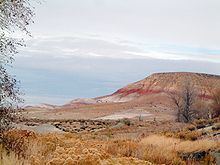Country USA | Thickness 150-400 ft | |
 | ||
Named by Nelson Horatio Darton, 1904 | ||
The Cloverly Formation is a geological formation of Early Cretaceous age (Aptian to Albian stage) that is present in parts of Montana, Wyoming, Colorado and Utah in the western United States. It was named for a post office on the eastern side of the Bighorn Basin in Wyoming by N.H. Darton in 1904. The sedimentary rocks of formation were deposited in floodplain environments and contain vertebrate fossils, including a diverse assemblage of dinosaur remains.
Contents
Stratigraphy
The Cloverly Formation rests disconformably on the Morrison Formation and is conformably overlain by the Thermopolis Shale. It is subdivided into a variety of members, depending on the location. In the Bighorn Basin along the Montana-Wyoming border, the Cloverly is divided into the following three members:
Age
Radiometric dating by the fission track method has yielded dates of 115 ± 10 Ma (million years ago) for the lower part of the Little Sheep Member and 108.5 ± 0.2 Ma near the top of that member, confirming that the Cloverly Formation is of Aptian to Albian age.
Environment of Deposition
The sediments of the Cloverly Formation were deposited in alluvial and floodplain environments. The basal conglomerates probably represent braided river deposits, while the sandstones were deposited in fluvial channels. The mudstones that contain most of the fossils represent overbank, lacustrine, and pedogenic deposits.
Vertebrate fauna
Animals recovered include the dinosaurs Deinonychus, Microvenator, Tenontosaurus, Zephyrosaurus and Sauropelta as well as fragmentary remains of Titanosaurs and Ornithomimids. As well, two genera of turtle Naomichelys and Glyptops and the lungfish Ceratodus.
Dinosaur eggs have been found in Montana.
References for data: Ostrom 1970; Cifelli et al. 1998; Cifelli 1999; Nydam and Cifelli 2002. Possible goniopholidid remains are known from the formation.
Saurischians
Theropod eggshell fragments are known from the formation. Unidentifiable ornithomimmid remains are present and most commonly represented by toe bones. Indeterminate allosauroid remains are known from the formation. Remains identified by John Ostrom as Ornithomimus are suspected by Jack Horner to be of a new ornithomimid genus.
Turtles
Possible goniopholidid remains are known from the formation.
Bony fish
Indeterminate amiiformes are known from the formation.
